This colorful, multiwavelength image of the intricate remains of Supernova 1987A is produced with data from three different observatories. The red color shows dust and cold gas in the center of the supernova remnant, taken at radio wavelengths with ALMA. The green and blue hues reveal where the expanding shock wave from the exploded star is colliding with a ring of material around the supernova. The green represents the glow of visible light, captured by NASA’s Hubble Space Telescope. The blue color reveals the hottest gas and is based on data from NASA’s Chandra X-ray Observatory. The ring was initially made to glow by the flash of light from the original explosion. Over subsequent years the ring material has brightened considerably as the explosion’s shock wave slams into it.
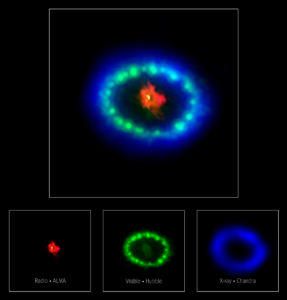

“The blob” in Supernova 1987A
Extremely high-resolution ALMA images revealed a hot “blob” in the dusty core of Supernova 1987A (inset), which could be the location of the missing neutron star. The red color shows dust and cold gas in the center of the supernova remnant, taken at radio wavelengths with ALMA. The green and blue hues reveal where the expanding shock wave from the exploded star is colliding with a ring of material around the supernova. The green represents the glow of visible light, captured by NASA’s Hubble Space Telescope. The blue color reveals the hottest gas and is based on data from NASA’s Chandra X-ray Observatory. The ring was initially made to glow by the flash of light from the original explosion. Over subsequent years the ring material has brightened considerably as the explosion’s shock wave slams into it.
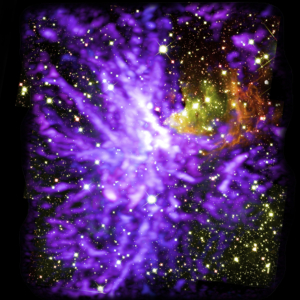
ALMA Mosaic Star Cluster
Image of star cluster G286.21+0.17, caught in the act of formation. This is a multiwavelength mosaic of more than 750 ALMA radio images, and 9 Hubble infrared images. ALMA shows molecular clouds (purple) and Hubble shows stars and glowing dust (yellow and red).
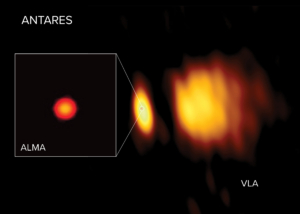
Radio images of Antares
Radio images of Antares with ALMA and the VLA. ALMA observed Antares close to its surface in shorter wavelengths, and the longer wavelengths observed by the VLA revealed the star’s atmosphere further out. In the VLA image a huge wind is visible on the right, ejected from Antares and lit up by its smaller but hotter companion star Antares B.
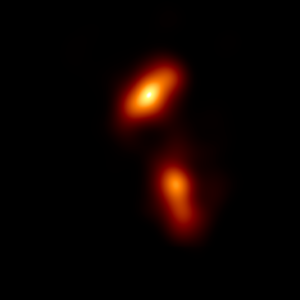
EHT image of quasar 3C 279
The Event Horizon Telescope observed the finest detail ever seen in a jet produced by a supermassive black hole. Quasar 3C 279 contains a black hole about one billion times more massive than our Sun. Twin fire-hose-like jets of plasma erupt from the black hole and disk system at velocities close to the speed of light: a consequence of the enormous forces unleashed as matter descends into the black hole’s immense gravity.
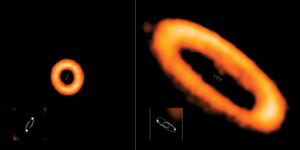
Aligned and Misaligned Circumbinary Disks
Two examples of aligned and misaligned protoplanetary disks around binary stars (circumbinary disks), observed with ALMA. Binary star orbits are added for clarity. Left: in star system HD 98800 B, the disk is misaligned with inner binary stars. The stars are orbiting each other (in this view, towards and away from us) in 315 days. Right: in star system AK Sco, the disk is in line with the orbit of its binary stars. The stars are orbiting each other in 13.6 days.





